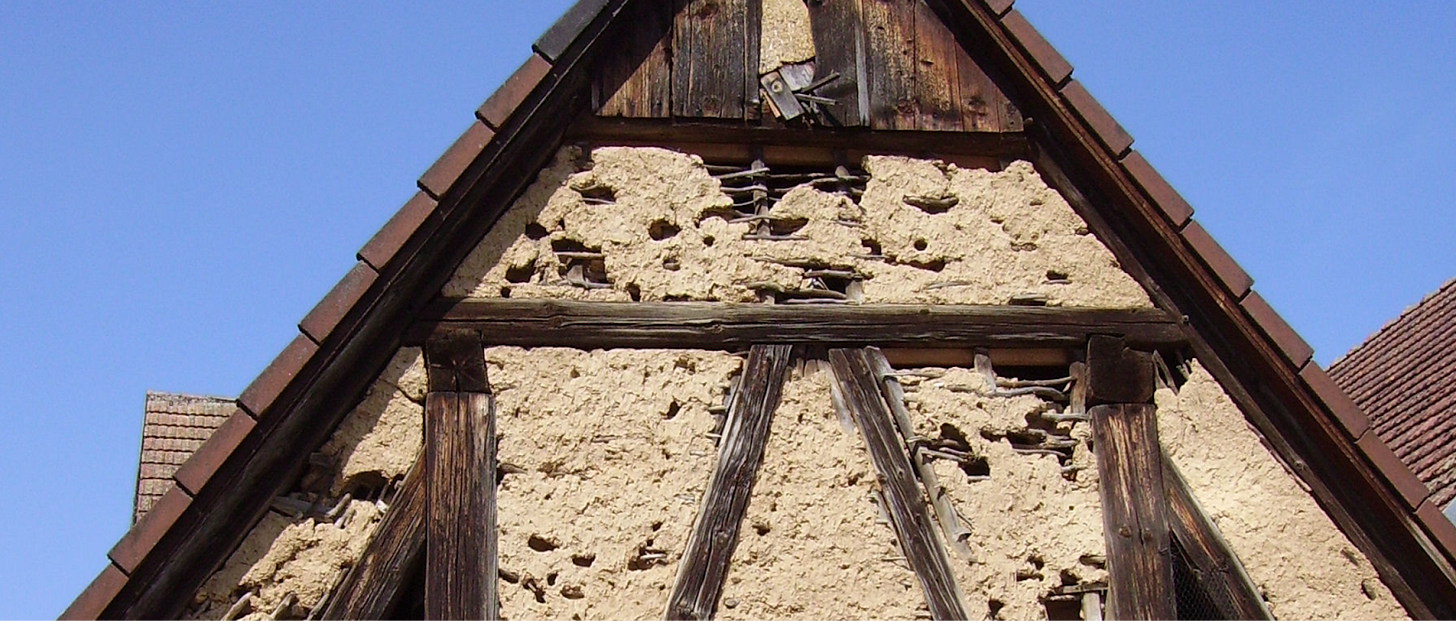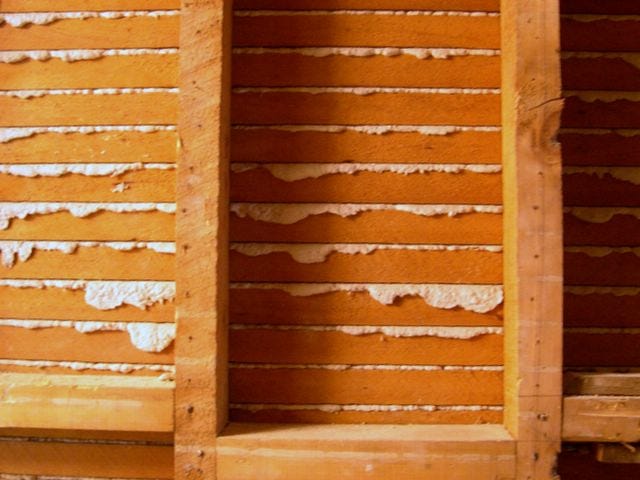We’re experimenting with turning on comments on our Substack. Please leave your thoughts below! We’re also hosting a Stripe Press pop-up coffee shop and bookstore on Saturday, June 28, in Washington, DC. RSVP here if you can make it.
Minecraft is not real life; you cannot stack blocks of dirt infinitely high. This is a shame, because dirt has a lot going for it as a construction material. It is abundant. You can go outside right now and scoop up a handful of dirt into your pockets without anyone stopping you. Just like in Minecraft.
To render dirt into a plausible building material, you need another Minecraft staple: wood. If you take a bunch of sticks, weave them into a tapestry, then slather wet dirt (also known by its technical name mud) and let it dry, you get wattle-n-daub, a method of constructing walls that has been a mainstay for at least 6,000 years, predating mud bricks. Some buildings standing today still have wattle-and-daub panels from 700 years ago.

If you fast-forward through the reel of history fast enough, it’s remarkable how consistent some activities are throughout the ages. The tried-n-true technique of slathering a moldable workable paste onto a rigid canvas as a way of constructing walls has barely budged across eons. Even past the industrial revolution, the cutting edge technique at the turn of the 20th century was plaster-n-lath. Instead of random sticks, you use uniform wooden strips. Instead of dirt, you use plaster made out of gypsum — a mineral known for its fire resistance. Same, but different.

The problem with slathering paste to make walls is that it is a skilled trade and incredibly labor-intensive. Creating a plaster wall on top of a lath canvas was done in-situ, and required multiple coats, each with its own drying time. You slather, then wait for it to dry, then slather on again, then wait for it to dry again. The walls of a typical home would take a skilled plasterer a week or two to make. The end result was either ok at best, or a wobbly warped mess. You are fighting against gravity after all.
As someone who has spent far too much time battling the quirks of a house built in 1901, I can personally vouch for the joys and sorrows of old plaster-and-lath walls. It’s impossible to mount even lightweight items such as picture frames onto the wall, because even the tiniest hole from nails or the like would crumble and erode into dust. Victorian-era homes relied on picture rail moulding near the ceiling, with hooks strung down to mount anything of significance. You can’t just pick any random spot to put up a picture of your cat; you have to dangle everything from one string, and if you’re dangling one you might as well dangle all.

The plaster mixture used then was a homegrown concoction, with recipes matching the climate needs and vernacular material availability. The popular additive was asbestos. While today we all know about its intense toxicity, the reason asbestos became so widespread from the 1870s until the 1970s was because it was extraordinarily fire resistant. It was better to die of a lung disease you didn’t even know about than to die in a house fire you definitely were cognizant of.
Which gets us to modern drywall sheets. Drywall, also known as gypsum board or plasterboard, is essentially a rigid panel made by pressing a thick layer of familiar gypsum plaster between two durable sheets of heavy paper. This creates a strong, smooth, and easily paintable surface that forms the backbone of most modern interior walls and ceilings. Developed in the early 20th century, it wasn’t until the 1950s that drywall rapidly took over as the standard for walls and ceilings in American homes.
Superficially, drywall looks the same as and is made of the same stuff as a plaster and lath wall. While both are a hardened layer of gypsum powder, drywall sheets are manufactured en masse off-site, in large factories under tightly controlled conditions for consistency and efficiency, then shipped to construction sites ready to install. Instead of a plasterer working his damndest to ensure straightness across a 12-foot tall canvas of paste, gypsum powder is trivially extruded into uniform shapes, sandwiched by protective layers of heavy-duty paper, like an inedible ice cream sandwich. Cheap, uniform, and free of defects.

The end product is simultaneously more robust and more malleable. Because drywall is a dense and uniform mixture, hanging anything off the wall (from pictures to heavier items like shelves, TVs, or even cabinetry) is a trivial exercise, either a simple nail for a small frame, plaster anchors for medium loads, or toggle bolts for the real heavy hitters.
Picture rails are a kitschy and twee feature that few people today even know their purpose, but anyone who tells you that they’re just as good for hanging things on are committing perjury. Speaking from experience, I have spent a not-insignificant amount of my life wrangling with the horrors of hanging things on old-fashioned plaster walls. Something as simple as putting up a coat rack turned into a months-long slog. Ideally you bolt it onto the load-bearing wooden studs, but plaster and lath foils the typical attempts of identifying where the studs are. Density scanners which differentiate the ‘empty’ gaps between studs are confused by the presence of wooden laths. Magnets which identify studs by the presence of metal nails are similarly foiled by the thicker plaster layer. Really, the only practical option is to drill multiple pilot holes until you hit something solid.
Modern glue-based options are also no match for the erratic plaster mixture of ye olde. Paint does not bite as well as it does on today’s paper coats, and sticker mounts will fall off older walls and drag a big chunk of paint down with them.
All of this adds up. By eschewing the lath lattices, buildings now have way more room in wall cavities for improved insulation and conduits.
Drywall’s fatal vulnerability has long been water damage. Fortunately, the quiet innovation engine is still humming along, churning out mold-resistant, fire-resistant, and soundproof drywall. There are even ‘smart drywall’ systems with integrated temperature, humidity, and sound sensors. You’re in luck if you’ve been hankering to have your wall connected to wifi.
Yes, this is all boring. No sane person should ever get excited about a blank wall, let alone read a thousand plus words on the subject. But your wall at home is a recurring reminder that most true architectural and design advancements are almost entirely invisible.
Yassine Meskhout is a public defender and writer.



Not boring. Fascinating. Thanks.
Well this was wonderful. Thanks. Nice to know the context we live within. And to appreciate all the workers and inventors who made our lives better.